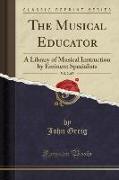- Start
- The Musical Educator, Vol. 2 of 5
The Musical Educator, Vol. 2 of 5
Angebote / Angebote:
Excerpt from The Musical Educator, Vol. 2 of 5: A Library of Musical Instruction by Eminent Specialists
We are all so familiar with the modern pianoforte that the fact of its being an entirely modern instrument is apt to be overlooked. Yet, whereas musical instruments of one kind or another have existed from the very earliest times, the inventions that gradually led up to the piano as we know it to-day were not made until about 1720, and no very material advance was made till considerably later than that date. Although it is true to say of the piano that its advance has called into the world the great virtuosi of present times, it is equally true to say that these virtuosi have called into the world the present-day piano, for the improvements in the instrument and in the technique of its players have advanced side by side until it is impossible to say which owes the other the more.
The most familiar forms of early stringed instruments played with keys like the piano were the spinet and the harpsichord. The spinet was known in England as long ago as 1668, but it was not till about 1740 that the first hammer harpsichord made its appearance in this country. This instrument was made by one Father Wood, an English monk at Rome, for a certain Mr. Samuel Crisp of Chessington, and, in writing about it, the contemporary chronicler says: "The tone of this instrument was superior to that produced by quills, with the added power of the shades of piano and forte, so that although the touch and mechanism were so imperfect that nothing quick could be executed upon it, yet in a slow movement, such as 'The Dead March in Saul, ' it excited wonder and delight."
The world's first pianoforte was invented and produced by Bartolomeo Cristofori, a Paduan harpsichord maker. His invention of the escapement and check action early in the eighteenth century opened up such wonderful possibilities for the instrument that from that day harpsichord makers and inventors everywhere brought their attention to bear on the subject, and pianos of various kinds were manufactured with varying success by a number of different makers. Of the names known in the pianoforte world to-day the two earliest to attract notice were Broadwood and Erard, but for a long time the attention of these and other firms was directed entirely to the manufacture of grand pianos, and it was not till about the year 1800 that John Isaac Hawkins, an English civil engineer living in Philadelphia, invented and produced the cottage piano, or upright grand. In his original instrument he anticipated almost every discovery that has since been introduced as "novel, " and the whole history of pianoforte manufacture began to undergo a complete change from that time.
About the Publisher
Forgotten Books publishes hundreds of thousands of rare and classic books. Find more at www.forgottenbooks.com
This book is a reproduction of an important historical work. Forgotten Books uses state-of-the-art technology to digitally reconstruct the work, preserving the original format whilst repairing imperfections present in the aged copy. In rare cases, an imperfection in the original, such as a blemish or missing page, may be replicated in our edition. We do, however, repair the vast majority of imperfections successfully, any imperfections that remain are intentionally left to preserve the state of such historical works.
Folgt in ca. 5 Arbeitstagen
